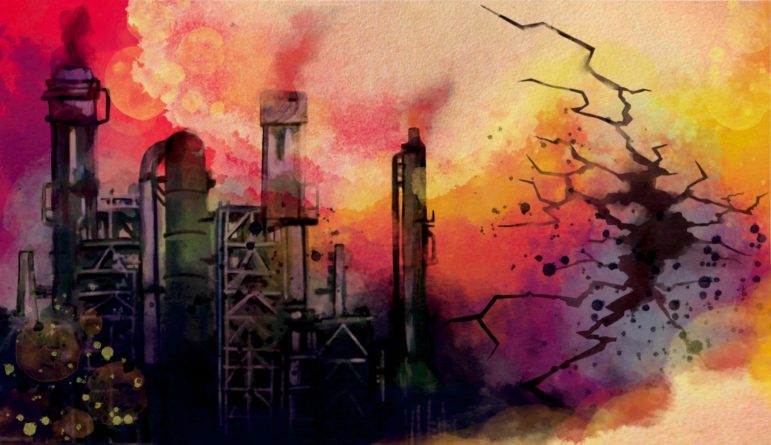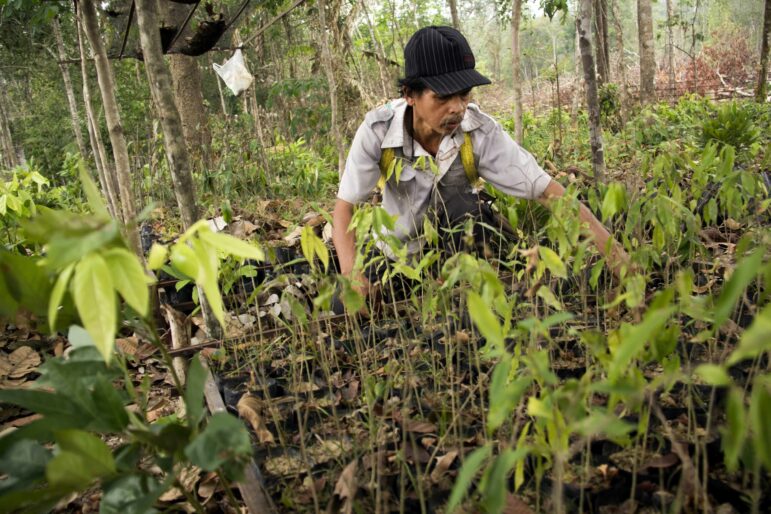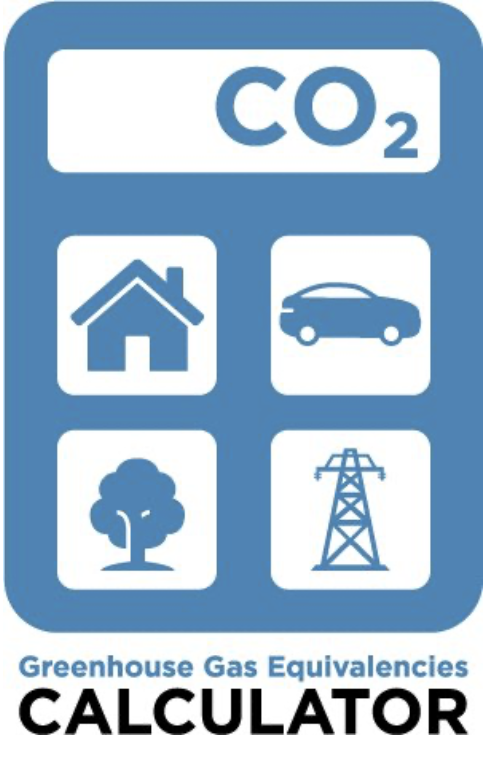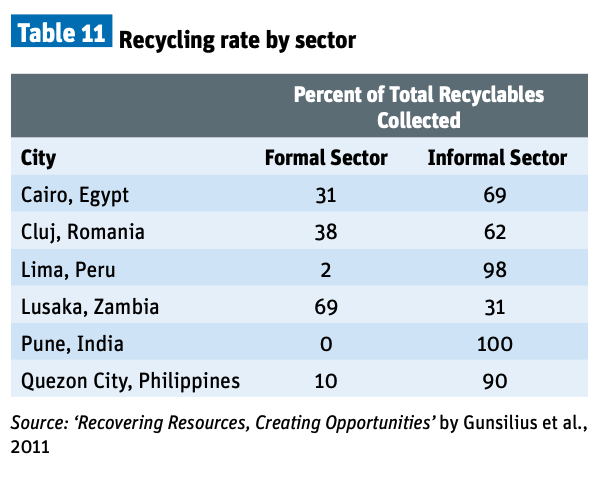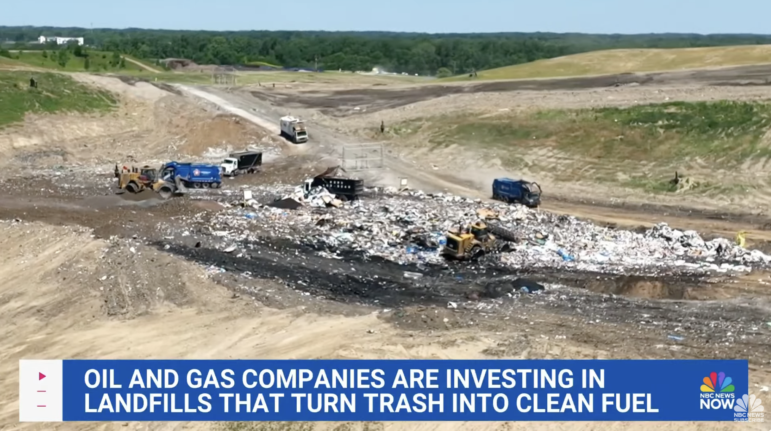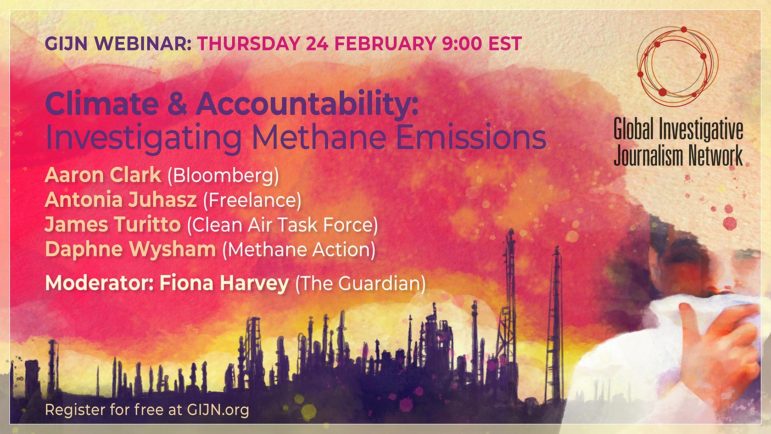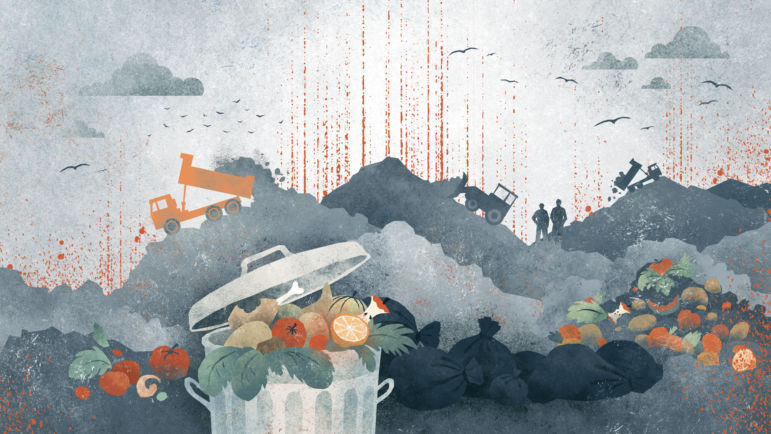

Illustration: Louiza Karageorgiou for GIJN
Methane gas spewing from landfills and waste dumps contributes significantly to global warming, but “garbage” often flies under the media’s radar.
Reducing methane emissions is one of the fastest and most cost-effective ways to slow climate change. Methane from the waste sector is the third-largest human source of methane after the agriculture and fossil fuel sectors.
Investigating methane emissions from waste sites and reporting on the practical solutions can be done worldwide. Plus, improving how waste is handled benefits the health of those living near disposal sites.
How waste is managed is not only a major climate change story, but also an important local story.
Learning about methane emissions is now easier because of the availability of satellite and remote sensing data. However, ground-level reporting is essential.
Solutions exist. There are practical and economical ways to reduce methane emissions from solid waste. Investigative reporting can explore whether viable solutions are being pursued, and if not, why.
This GIJN guide will describe what resources are available and what questions to ask about methane emissions from landfills and how to reduce them.
The main topics covered are:
- How landfills contribute to climate change
- Finding out about methane emissions
- What to ask about solutions
Examples of great investigations on the issue can be found at the end of this guide.
Section One: The Big Picture
Methane emissions are a major contributor to global warming.
The decomposition of organic matter in an oxygen-free environment results in the creation of methane gas as one by-product.
Methane (CH₄) is the second-largest contributor to climate warming after carbon dioxide (CO₂), which is more abundant and longer-lasting. Methane, over a 20-year time frame, is 80 times more potent than carbon dioxide as a greenhouse gas. “A molecule of methane traps more heat than a molecule of carbon dioxide, but methane has a relatively short lifespan of seven to 12 years in the atmosphere, while CO₂ can persist for hundreds of years or more,” according scientific research. (See a summary by the US National Aeronautics and Space Administration (NASA).)
Decomposition happens in nature all the time, resulting in methane emissions. Rising temperatures are accelerating methane emissions — for example, in the Arctic tundra. But human activities are the real culprits, generating an estimated 60% of all methane emissions. (See NASA and other sources listed at the end of this section.)
Organic waste, such as food and paper, accounts for about 20% of anthropogenic (human-caused) methane emissions worldwide, according to the 2021 United Nations Global Methane Assessment: 2030 Baseline Report. Agriculture accounts for 40% of methane emissions (32% from livestock, 8% from rice production), and fossil fuels contribute another 35%, the same report said.
Waste Production Increasing
The amount of waste is projected to increase.
“By 2050, in a business-as-usual scenario, the world is projected to generate 73% more MSW (municipal solid waste) than in 2020,” the World Bank said in a 2023 report.
“Every year across the globe more than two billion tons of municipal solid waste (MSW) is generated,” according to a 2024 report by the UN Environment Programme (UNEP). “If packed into standard shipping containers and placed end-to-end, this waste would wrap around the Earth’s equator 25 times, or further than traveling to the moon and back.” (And that doesn’t count construction and demolition waste, industrial waste, agricultural waste, and health care waste.)
“High-income countries produce the most waste per capita, where rising incomes and consumption have been associated with higher waste generation,” the World Bank noted. But that could be changing. The report elaborated: “Going forward, waste generation rates in most high-income countries are expected to either remain stable or slightly increase. Middle-income countries, conversely, are projected to see the largest increase in both per capita waste generation and total waste generation.”
The generation of more waste “will be driven by high levels of growth in both economic activity and population” and urbanization, according to the World Bank. “Waste volumes are projected to grow by more than 2.5 times for low-income countries (LICs) and nearly double for middle-income countries.”
Want another metaphor?
The world population generated 1.9 gigatons per year of municipal solid waste (MSW) in 2015 and is expected to generate about 3.5 gigatons per year of MSW in 2050, according to one study. That’s a lot. A gigaton is 1,000,000,000 metric tons. (A metric ton equals 2,205 pounds, about 10 percent heavier than a US ton.)
The authors of the study said that projected waste in 2050 would equal the weight of 200 million elephants; enough elephants to stretch from the Earth to the moon.
Landfills Everywhere
Where does all that waste go?
There are 48,000 landfills worldwide, according to a 2022 estimate by the UK publication Landfill Today.
There’s a distinction between “landfills,” where methods are being employed to mitigate environmental damage (such as liners to prevent water seepage), and “waste sites,” where there are no controls and garbage is simply dumped, and often burned.
The 2024 UNEP report said 38% of the MSW generated globally in 2020 was “uncontrolled.” Over 90% of waste in low-income countries is still openly dumped or burned, according to a 2018 World Bank report. One study of India identified 3,184 existing dump sites, handling about 160,038.9 tons per day of solid waste, with only half of it treated.
While “open” burning and random dumping of waste is widely seen as environmentally damaging, incineration to produce energy (waste-to-energy) is controversial. Burning causes carbon dioxide emissions, along with “black carbon” and other pollutants. This guide, however, focuses on landfills.
Managing all waste properly, in landfills, is costly. “Municipalities in low-income countries are spending about 20% of their budgets on waste management, on average,” according to a World Bank report.
Other Pollutants, Too

Nine hundred and fifty tons of obsolete pesticides being excavated from a landfill in Minsk, Belarus, to be packed into barrels and shipped for destruction. Image: Irina Oleinik, World Bank photo collection (Creative Commons)
While this guide is focused on methane emissions, there are many other types of toxic pollution from landfills that have negative health consequences.
Some of the other pollutants from landfills are airborne, while others leach into the soil and groundwater. These pollutants, and their effects, include:
- Benzene, which causes cancer, found mainly in plastics;
- Volatile organic compounds (VOCs) that react in the sunlight with nitrogen oxides to form ozone pollution, which can cause respiratory health problems;
- Hydrogen sulfide, which smells like rotten eggs and can cause irritation to the eyes and respiratory system, and derives mainly from gypsum wallboard;
- Toluene, which damages the nervous system, and is used in many applications as a solvent;
- Per- and polyfluoroalkyl substances (PFAS), also known as “forever chemicals.” According to new research, landfill gas serves as a major pathway for the release of PFAS.
And methane, besides being a potent greenhouse gas, contributes to ground-level ozone that is linked to respiratory diseases and premature deaths.
Dumping garbage outside of landfills can damage the environment, often with significant human and economic consequences. For example, wetlands can be destroyed, natural fisheries can be degraded, and beaches polluted.
In addition, poor and Indigenous populations are more likely to be negatively affected by waste disposal and pollution, since these sites are often located in their vicinity. Not to mention the impact on waste-site workers, including those in the “informal sector” who scavenge sites. In the US, the modern environmental justice movement can be traced, in part, back to “Dumping in Dixie,” a 1990 book showing that landfills were disproportionately sited next to poor and Black communities.
Noxious smells and increased illness in neighboring communities may well be important subjects for stories. Gypsum drywall has been associated with the generation of hydrogen sulfide. Odors may also signal leaky gas collection systems. “If you smell something, that is oftentimes indicative of a problem,” said Tom Frankiewicz, who leads Waste Sector Methane Mitigation at the Rocky Mountain Institute (RMI), an independent, non-partisan, nonprofit organization.
In sum, many waste management problems, and solutions, are related to methane emissions.
Solutions Are Available
While the problems seem overwhelming, journalists should be aware that a wide variety of cost-effective solutions can yield significant benefits, according to policy experts.
Methane emissions from waste are largely preventable and need to be reduced by at least 30 to 35% to limit global warming to 1.5°C., according to the UN’s 2021 Global Methane Assessment.
“Transforming open dumpsites worldwide into sanitary landfills, while diverting organic waste to composters and bio-digesters, can decrease methane emissions by 80% (60–89%)… “ according to a study published July 2025, in Nature Climate Change.
The solutions are good investments. As much as 60% of waste-sector targeted measures are low cost or pay for themselves quickly by saving money (negative cost), according to the report.
The waste sector has proven to have the greatest mitigation potential for sources of pollution after the oil and gas sector, even though it only contributes 20% of overall emissions.
More on solutions to come later, but first a look at measurement.
Resources (listed in order of relevance and value):
Waste Sector: Methane Emissions Flying under the Radar, The Rocky Mountain Institute, 2025
Global Waste Management Outlook 2024, UNEP, 2024
Global Methane Assessment: 2030 Baseline Report, UNEP, 2022
Municipal Solid Waste Management and Adverse Health Outcomes: A Systematic Review, International Journal of Environmental Research and Public Health, 2021
More Growth, Less Garbage, World Bank, 2021
Methane, Climate Change, and Air Quality in Europe: Exploring the Connections, European Environment Agency, 2025
Food Waste Impacts: Climate and Resources, ReFED, a US NGO, 2025
Open Dumping, UN Environmental Programme, 2025
Guidance on Solid Waste and Health, World Health Organization, 2024
Methane Emissions from Open Dumpsites in India: Estimation and Mitigation Strategies, Centre for Science and Environment, 2023
Trashing the Climate: Methane from Municipal Landfills, Environmental Integrity Project, 2023
Quantifying Methane Emissions from Landfilled Food Waste, US Environmental Protection Agency (EPA), 2023
Waste Methane 101: Driving Emissions Reductions from Landfills, RMI, 2023
How Our Trash Contributes to Climate change — and What We Can Do About It, the Clean Air Task Force (CATF), 2022
How Circular Waste Management Systems Can Benefit the Environment, Nature Communications, 2021
Zero Waste and Economic Recovery. The Job Creation Potential of Zero Waste Solutions, GAIA, an international NGO, 2021
What a Waste 2.0, World Bank, 2018
Buried Consequences: The Chiquita Canyon Story, a video by the US nonprofit Industrious Labs about a California landfill, 2025
Basic Information about Landfill Gas, US EPA
Landfill Gas Primer – An Overview for Environmental Health Professionals, the Canadian Agency for Toxic Substances and Disease Registry
Section Two: Identifying Methane Emissions

Illustration: Louiza Karageorgiou for GIJN
Methane is invisible to the naked eye, but emissions can be made visible and documented using a variety of techniques, both on the ground and from above.
“We can’t really manage it if we don’t measure it,” said David Risk, a Canadian methane researcher, while telling the CBC about a simulation project run by FluxLab, an organization he heads.
Satellites, airplanes, and drones are increasingly a great source for images and emissions data.
The levels of emissions seen from above frequently exceed what’s officially reported. Ground measurements of methane emissions, from oil fields and landfills, are regularly underestimated. A 2024 study by Carbon Mapper in the US found “a large discrepancy and generally poor correlation” between what scientists observed from the air and what was reported to the US government. This underestimation was supported by an earlier NASA study.
Ground measurement can be gathered by landfill operators, but the results can be hard to get. Governments could mandate measurement, or do it themselves, but often do not. Instead, the focus is more on finding major leaks than identifying emission rates. Even when operators are mandated to report emissions, the data may not be made public.
“[W]hile tools to collect data exist, their application and translation into actions are lacking, meaning there is a huge untapped potential of unlocking action and finance through data collection and data use,” according to a March 2025 report by the Climate and Clean Air Coalition (CCAC), a multilateral group whose Secretariat and Trust Fund is hosted by UNEP.
More transparency is needed about potential solutions, according to the CCAC. “Key data gaps include the volume and composition of waste (particularly food loss and waste), and the quantified benefits of relevant prevention, recovery, and recycling solutions on human and ecosystem health, job creation, and economies,” according to CCAC. The report includes forms to be used for data collection.
The CCAC LOW-Methane Data Strategy has supported some national projects, “designed to unlock action on methane mitigation from organic waste by improving data collection, analysis, and application.”
Methane Tracker from the International Energy Agency provides estimates of annual national methane emissions from the waste sector.
What Are the Units of Emission Measurements?
Methane emissions are usually expressed as the volume emitted per hour: kilograms per hour (kg/hr) or tons per hour.
To make these figures more relatable, the Guardian wrote: “An outburst near Lahore in Pakistan in February leaked at 214 tons an hour, equivalent to 34 million car exhausts.”
There’s a tool to make this conversion: the Greenhouse Gas Equivalencies Calculator, run by the US EPA.
From Above: Satellite Images Proliferating
Orbiting satellites are providing valuable data on greenhouse gas emissions, including methane from landfills.
GIJN did some test drives and learned that the data can be very useful, but with some caveats. The main one being that supplementary ground-level reporting is essential.
Satellite data usually includes longitude and latitude coordinates for specific emissions but may not pinpoint a landfill and usually does not identify the emission source by name. This means it’s essential to use your local knowledge of landfill locations to figure out where the emissions are coming from and who’s responsible.
Here are a few other things to keep in mind about satellite images:
- Satellite observation has its complications. The circling cameras take snapshots, but there are important variables, including how often the satellite flies over the site and the resolution of the images. Winds blow emissions, which is why the plumes shown are often elongated. Interview the sources of the information about the data and its limitations.
- Note that the providers usually include an “uncertainty factor.”
- The data provided by these sources typically is at least 30 days old, usually due to contractual obligations of providers who sell the data commercially.
For a detailed explanation of satellite detection of methane, read a April 2025 report by The Center for Law, Energy & the Environment (CLEE) at the University of California, Berkeley, and The Emmett Institute at the University of California, Los Angeles.
After looking at the data online, ask for assistance from the data providers. They may help you navigate the maps and the data. On request, some will provide more specific and more periodic observations. Many of these sources will work with reporters.
Satellite Image Sources
These sources are listed roughly in order of how much information is available.
Carbon Mapper: This US nonprofit posts global carbon dioxide and methane emissions from the fossil fuel, waste, and agriculture sectors on a searchable map. To refine the view to methane plumes from waste specifically, find the tiny print “Show Filters” just below the search bar. Locate “Sector” and pick “Solid Waste.” Also select “CH4.” This will pull up plumes of methane — indicated on the map as purple circles — that have been observed by airborne and satellite instruments. At the geographic location you want, click the circle to pull up a specific plume and get key details about the observed emissions event, such as the emissions rate and the number of observations. Previous observations, if available, are shown in a box in the right corner. There’s also a Product Guide. You can create saved searches and receive email alerts for newly published data on the Carbon Mapper portal. Press contacts are Kelly Vaughn (kelly@carbonmapper.org), Annabelle Blair (annabelle@carbonmapper.org) or media@carbonmapper.org
Methane Alert and Response System (MARS): This international methane tracking effort is run by the UN Environment Programme, relying on many public and private sources. The map view can be narrowed to “waste” and by date. Clicking on the identified spots will bring up emissions information. While in map view, click the vertical words “Access Data” to see various download formats. UNEP has an access to information policy that may be used to make requests for additional information. However, UNEP will not provide the notices it sends to governments about significant emissions. Reporters could try using national access laws to request the notices. Contact isunep-newsdesk@un.org.
The CAMS Methane Hotspot Explorer: New in 2025, this resource shows large methane plumes from strongly emitting localized sources using European Space Agency Copernicus Sentinel-5P TROPOMI methane satellite data. The data are updated daily and provide global coverage. Select source type, “Urban/landfill” and set the time period on map. The map shows only the last 14 days, but all data can be downloaded. Hover over identified spots to see more information. The exact sources usually are not identified, but the most likely source type is. See documentation. Contact the Copernicus press team.
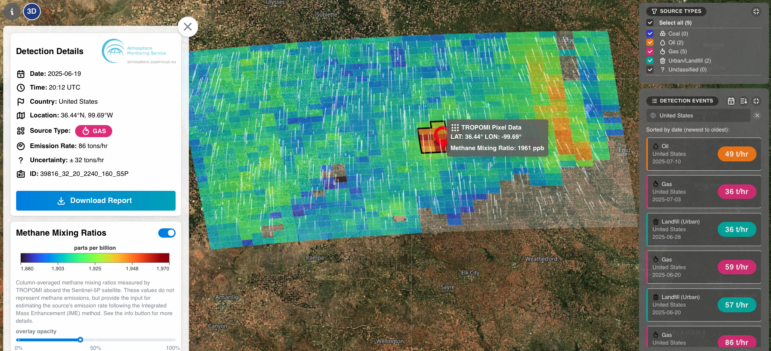
Image: Screenshot, CAMS Methane Hotspot Explorer
EMIT Open Data Portal: A resource from NASA. In the upper left corner, use the Layer option to choose “Methane Metadata.” The time slider allows a focus on specific date ranges, and you can play with the range by clicking the play button at the left. On the map, click the red circles to see the time and concentration of the emissions. NASA uses parts-per-million-meter (ppm-m). (See an explainer here.) Contacts: Andrew Wang (andrew.wang@jpl.nasa.gov), Jane Lee (jane.j.lee@jpl.nasa.gov), or hq-media@mail.nasa.gov.
GHGSat Spectra: A periodically updated map posted by the Canadian-based company, GHGSAT, includes a selection of recent major emissions worldwide, usually about seven months old. (Sign-up is required for access.) Clicking on any of the locations shows a table of the featured emissions and identifies some as “waste management.” Also provided: the time the image was taken and rate of flow. The precise location is not given, but there’s a close-up image of the plume. Above the map it says: “Upgrade your account to add real-time emission, catalog data and analytics!” A spokeswoman said that, upon request the company will “share aggregate statistics about the prevalence of emissions at a regional level to give a sense of scale” and also provide specific local data to journalists. Contact Alison Boyer (aboyer@ghgsat.com) or info@ghgsat.com.
Kayrros Methane Watch: The French company Kayrros offers some of its data for free. The Kayrros map, after you click “Access Data,” allows you to narrow a search. See “Source Type” and click on “Other Human Activity” (the category in which landfill emissions would fit). You also can define the timeline. The map may show multiple readings from a location, as overlapping orange circles, but these are not easy to click on. Instead, go to “Download Data” at the lower right and use the tool with the connecting dots to define the area of interest. Then download the data. Media contact: team-kayrros@sonder-london.com
Climate Trace: The not-for-profit coalition has a map that can be narrowed to cover the waste sector (and five sub-sectors). There were 363 sites identified in a May 2025 check. Methane emissions data (in a CO₂ equivalent) is shown, but you can also switch to methane by using the drop-down menu at the top right of the screen. Updated monthly. Media contact: media@climatetrace.org
WasteMAP: This US nonprofit identifies specific landfills on a map and estimates how much methane they are emitting. These estimates are based on public data from a variety of sources, modeling, and sometimes satellite images. WasteMAP researchers also calculate total country and city emissions. The data here is mostly from 2022, but projections are made for identified locations. The project was created by the Rocky Mountain Institute and the Clean Air Task Force. Media contact: wastemap@rmi.org.
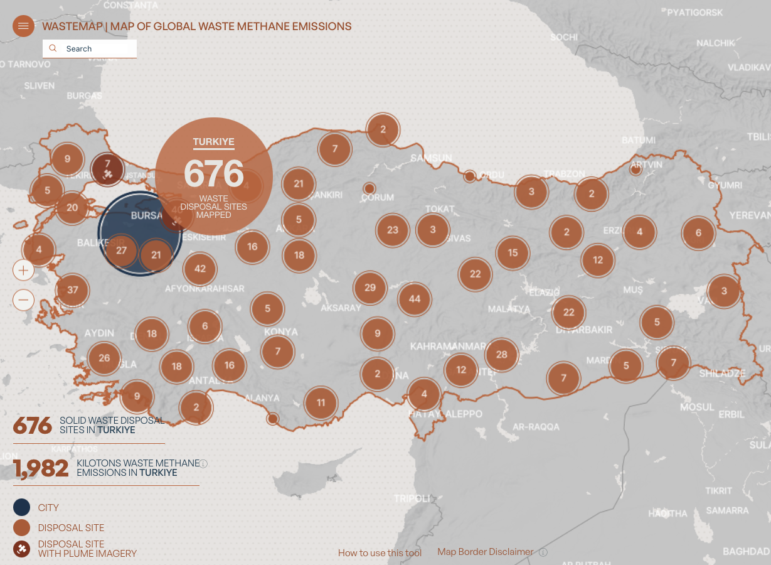
Image: Screenshot, WasteMAP
Landfill Map by Watershed: To identify waste sites in Europe, checkout this interactive Landfill Map by Watershed, run investigative journalists Rachel Salvidge and Leana Hosea. While this resource does not deal with methane releases, it does show the locations of more than 60,000 landfill sites. Users can overlay the maps with data on flood zones, coastal erosion, drinking water supplies, chemically failing groundwater, and conservation areas.
For a detailed explanation of satellite detection of methane, read this April 2025 report by The Center for Law, Energy & the Environment (CLEE) at the University of California, Berkeley, and The Emmett Institute at the University of California, Los Angeles.
On the Ground: Landfill Operators Collect Data
Satellite data can be a great starting point for an investigation, but it isn’t essential and needs to be supplemented with other information to fill out the picture.
Interview landfill operators and relevant government officials. They may be skeptical about the satellite data and say the problems have been fixed, but there’s lots to ask about what they know about methane emissions.
Starting questions for landfill operators:
- What data exists on your methane emissions?
- What methods do you use to monitor emissions?
Be prepared for complex answers and be skeptical.
“[M]any of these large persistent landfill emissions are not included — or are misrepresented — in traditional emissions accounting methods,” said Tia R. Scarpelli, staff scientist at Carbon Mapper in 2024 testimony to a US Senate committee.
Importantly: ask for documentation.
In some countries, landfill operators are required to file reports with regulators. If so, the documents may or may not be covered by freedom of information laws.
Seek out local environmental groups, scientists, and other experts.
A lack of data from a landfill operator is itself a story. No measurements? Why not?
Now let’s look at the ways emissions are measured on the ground.
Ground-Level Measurement Techniques
The quality of data gathered on site depends on which measurement techniques are used and how well, among other factors.
Ask landfill operators about their practices.
Measurement techniques include walking surveys with handheld methane detectors that use laser technology to map emissions.
“There is no single monitoring technology that can ‘see’ all of the methane at the granularity that’s needed at landfills,” Scarpelli wrote in a 2024 article about research on US landfills. Getting too close to the “working face,” where trucks drop off their loads, may be dangerous, Scarpelli wrote, “… which means that large emission sources may be missed during the survey.”
Her research showed that much of the methane released, at least at US landfills, comes from the working face, where solid wastes are discharged, spread, and compacted before being eventually covered up. Operators also commonly identified construction activity on the landfill surface, malfunctioning gas wells, taking gas capture wells offline, and cracks in surface cover as sources of emissions, she found.
Robotic dogs equipped with methane sensors are now patrolling landfill sites, and drones are being used to measure emissions, too, RMI reported: “Compared to traditional monitoring, where a technician walks the site for miles, these methods are safer, more efficient, and more economical.”
See a summary of techniques on page eight of the CCAC report. Also note a Waste Wise Cities guide from UN-Habitat with seven steps for collecting data on municipal solid waste.
Methods matter. But even if some methods have faults, the data over time may identify trends.
Monitoring also applies to “flaring,” or burning off of landfill gases. Flaring does reduce methane emissions, but is not ideal compared to other solutions. Flares not operating correctly increase methane release, so monitoring is necessary. “Enclosed” flaring is an alternative that produces minimal emissions, although it does create some particulate air pollution. The World Bank’s Global Gas Flaring Tracker has data and reports on flaring, but not on specific landfill sites.
Can reporters use handheld methane monitoring devices? Not really.
First, without access to the landfill, accurate measurements can’t be taken.
Second, infrared cameras and other specialized equipment used from a distance can show the existence of methane emissions from point sources, such as flare stacks and vents, but not more dispersed emissions. These devices are expensive and require training, so it’s probably best to work with environmental groups, some of which are happy to help journalists in joint projects. (For more, see the investigating leaks and emissions chapter of GIJN’s Methane Guide.)
Nevertheless, images from infrared cameras do provide excellent graphics. Satellite images can serve the same visual purpose.
Finally, what goes into a landfill will affect what comes out. Estimating emissions by measuring inputs is also feasible, although complicated.
The Solid Waste Emissions Estimation Tool (SWEET) is an Excel-based tool that quantifies emissions of methane, black carbon, and other pollutants from sources in the municipal solid waste sector. The tool was created by the Global Methane Initiative, an international public-private project. While it’s designed for experts, landfill officials can use it as well — for example, in detailed studies, such as this one from 2022 on Accra, Ghana. Journalists can ask landfill officials if they use it or similar tools to track output from their sites
Resources:
Low-Methane Data Strategy: Unlocking Action Through Waste and Methane Data, the Climate and Clean Air Coalition, 2025
Hunting Methane Using Satellites, The Center for Law, Energy & the Environment (CLEE) at the University of California, Berkeley, and The Emmett Institute at the University of California, Los Angeles, 2025
A Guide to Monitoring and Quantifying Methane Emissions from the Waste Sector, CATF, 2024
Deploying Advanced Monitoring Technologies at US Landfills, Rocky Mountain Institute, 2024
Waste Characterization Handbook: Understanding Municipal Waste Streams to Develop Data-Driven Methane Mitigation Strategies, the US EPA on behalf of the Global Methane Initiative, 2024
Using Satellites to Uncover Large Methane Emissions from Landfills, Science, 2022
Waste Wise Cities, UN-Habitat, 2021
Section Three: Solutions
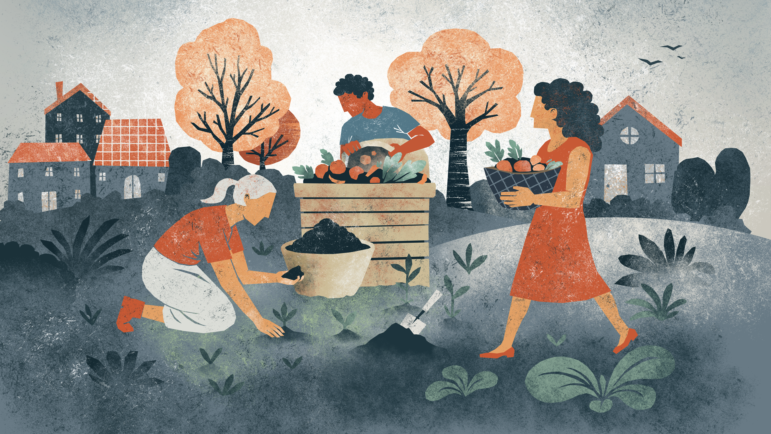
Illustration: Louiza Karageorgiou for GIJN
A variety of actions could significantly reduce greenhouse gas emissions from landfills. Delving into possible solutions during reporting may be the real value of a landfill investigation.
Potential solutions include:
- Reducing the amount of organic material disposed of in landfills.
- Capturing emissions for a renewable source of energy, sometimes called bio-gas.
- Cutting emissions with improved landfill operations.
- Setting emissions limits through law.
More below on each of these, but also check out a thorough survey option of solutions and implementation steps by the Clean Air Task Force (CATF), The Waste Methane Toolbox: Policy Solutions for a Low Methane Future, which notes that waste and wastewater are responsible for approximately 20% of global anthropogenic methane emissions. That’s equivalent to roughly 5.4 gigatons of carbon dioxide equivalents annually, says CATF. Country examples are provided for Colombia, Germany, India, Italy, Perú, the Republic of Korea, and the US.
CATF wrote, “When we consider examples of countries that have successfully used these approaches to improve waste management and reduce climate impacts… it becomes clear that there is no silver bullet or single solution to achieve this goal.”
But the benefits can be substantial.
Reductions of about 80% below baseline methane emissions by 2050 could be obtained if reform steps are taken, according to a 2020 study by scientists published in Environmental Research Communications.
“Fortunately, there are a number of technically feasible, readily available strategies to reduce landfill emissions today, at modest cost,” said the RMI’s waste expert Frankiewicz in his 2024 testimony before a US Senate committee.
“Modernizing landfill operations — through comprehensive leak detection and repair, expanded gas collection system coverage, and enhanced cover practices — can cut methane immediately from waste-in-place, while protecting nearby communities from co-pollutants,” according to Frankiewicz.
He also said that “scaling up efforts that keep organic waste out of landfills — through strategies like edible food donation and composting — will avoid future landfill methane generation and ensure organic materials are put to their highest and best use in the circular economy.”
“The economics of it check out,” said another expert, who works internationally but preferred not to be quoted because of his institutional connection.
There is increasing private sector interest because some of the solutions can be economically viable. “Bankability is becoming the big story,” according to the same expert. But investment is slow to come, and what there is, is mostly for extraction of bio-gas. More on that below.
Some financial assistance for landfill improvements has been provided by international development agencies, such as the World Bank. Some mitigation projects have been funded by the CCAC, a UNEP initiative, including in Panama, Senegal, Nigeria, Uganda, Argentina, Cambodia, Paraguay, Brazil, Pakistan, Costa Rica, and Liberia. (The list includes those started in 2024.)
However, the prospects for implementing solutions vary widely.
One study published in the journal Waste in 2025, began: “In sub-Saharan Africa municipal solid waste management faces significant challenges, including inadequate infrastructure, increasing waste generation, and limited resources, leading to severe environmental and public health issues.” The article said that governance structures, data availability, and informal practices prevalent in sub-Saharan Africa make it “difficult” to introduce appropriate innovations in waste management customized to local needs.
In terms of climate change ambitions, in many developing countries there’s a significant disconnect between national climate change goals for the waste sector and what is achieved, according to the 2021 World Bank report Bridging the Gap in Solid Waste Management.
“Central authorities often regard solid waste management as a local function and beyond their mandate,” the report says. “Line ministries often do not see it as being either their role or practical for them to provide the guidance, support and resources needed by local authorities to implement national policy. Yet, the primary responsibility for setting the overall institutional, policy and legislative framework for the municipal waste management sector belongs with central governments.”
A taste of how large the challenges are is provided in a 2025 study of three rural Cambodian cities. All waste was going to “unsanitary open dumpsites without soil coverage, landfill liners, leachate treatment facilities, or gas control systems.” Plus, “open burning of waste was observed across all the landfills and temporary dump sites,” according to the researchers.
For investigative reporters, this means that there will be many different situations and possible solutions.
Mitigation efforts may already be underway, so the questions to ask may be about whether they are working.
“Most” landfill operators, said Frankiewicz, who consults internationally, “are trying to do the right thing, but it’s challenging.”
What to Ask, Who to Ask
Approaching landfill operators and government officials might best be done initially with open-ended questions about the problem and what solutions are being employed or being considered.
National governments have an interest in this. In pursuit of global climate change goals, most governments make pledges to reduce greenhouse gas emissions.
Senegal, for example, aims to reduce its overall methane emissions 7% by 2030, or by 29% over the same period if external assistance is provided. “For the waste sector, Senegal’s emissions reduction intentions are set at 11% until 2030 and up to 65% if adequate external funding can be provided,” summarized a UN report.
Getting to these goals will involve various strategies.
Financially strapped countries lacking basic infrastructure may need quite different approaches, as described in A Playbook for Municipal Solid Waste Methane Mitigation by the Rocky Mountain Institute.
The playbook identifies four municipal solid waste management types. The lowest category is “characterized by low to medium collection rates, poor waste management systems, low recycling rates, and limited or no waste treatment prior to final disposal.”
The playbook — which is a good primer for reporters — describes strategies to mitigate methane for each of the four archetypes, “providing a starting point for countries to further customize methane abatement solutions unique to their local context.”
For countries in the lowest category, lack of access to finance for capital projects is “a major obstacle.” As a result, “these countries can start reducing methane emissions by building basic infrastructure or implementing relatively low-cost operational improvements at the dumpsites.” These strategies “can include developing small-scale decentralized organics processing facilities, limiting waste pickers’ access to dumpsites, installing landfill covers, and installing basic gas capture and control systems (GCCS).” Examples given include the Dominican Republic, Guatemala, Nepal, Nigeria, Tajikistan, and Uganda.
The playbook doesn’t list all countries by categories, although it gives a handful of examples.
Use the categories in exhibits four through nine as a basis for questions. Pathways can be read in conjunction with a 2022 RMI report on “key strategies.”
Similarly useful as a source of ideas for questions is CCAC’s LOW-Methane Data Strategy.
Potential Sources
There are many sources to consult, including:
- Environmental groups, especially those concerned with climate change;
- Other non-governmental organizations and civil society organizations, including those looking to cut government costs and to reduce food waste;
- Scientists and social scientists;
- Waste management trade associations;
- Businesses looking to cut their waste costs or help others do so;
- Businesses hoping to profit from recycling, composting, and gas capture;
- Potential customers for products such a fertilizer;
- Affected citizens, such as neighbors of landfills.
Searching for news about landfills in your area may prove useful.
Here’s more about four main strategies for reducing methane emissions from landfills, followed by a collection of resources.
Reducing Organic Material Levels
Diverting organic waste from landfills can reduce methane emissions and pay other dividends.
“A third of the global trash mountain ‘built’ every year is generated by about one-sixth of the population (high-income countries),” noted one group of researchers, adding, “However, only around 13% is recycled and 5.5% composted.”
Reducing food waste is considered key. “Because food waste is the largest component of the organic waste stream, food loss and waste prevention is the best option to reduce methane emissions from municipal solid waste,” according to RMI’s Playbook. Keeping biodegradable waste from being sent to landfill is also underscored in an analysis by the International Institute of Applied Systems Analysis.
The mantra of “reduce, reuse, and recycle” will keep organics out of landfills. Among other things, food waste can be composted and paper can be recycled.
Plastics in the waste stream “is a major challenge to the diversion, recovery, and treatment of organic waste,” according to CATF’s The Waste Methane Toolbox. The amount of plastics can be reduced with a variety of prohibitions and incentives, the report says. Doing so reduces the cost of later separation.
Reducing organic waste disposal requires not only political will but also behavioral changes by the public and increased capital investment. For example, a 2022 report on Ghana underwritten by the World Health Organization noted that increased composting and recycling “would likely be preferred by society, but needs significant investments in capital, skilled labor, planning capacity and societal participation in waste separation.”
Figuring out the social, financial and political details can be complex.
Among other things, in many places, waste pickers are a key part of the equation — totaling an estimated 15-20 million individuals worldwide, who focus primarily on plastic recycling. “In Colombia, waste pickers have transformed their social and professional status, evolving from being seen as ‘disposable people’ to being recognized as providers of public recycling services,” according to a 2024 article by the Platform Cooperativism Consortium. Women in Informal Employment: Globalizing and Organizing (WEIGO) points out: “It is well established that waste pickers contribute to reducing greenhouse gas emissions in many cities and are the backbone of recycling.”
National efforts are being tried in some countries.
The Swachh Bharat (Clean India) Mission, started in 2014, includes segregation of waste among its goals, and envisions diverting 80% of municipal solid waste from landfills by 2026.
There has been progress, but the Swachh Survekshan (National Sanitation Survey) for 2023 said India’s national waste processing average remains below 40%. Similarly, a 2023 report by the Centre for Science and Environment, a public interest research organization based in New Delhi, says about half of the total waste generated in the country remains uncollected.
Even when diversion tactics are being used, oversight is warranted. Watchful reporting by the Hindustan Times exposed weaknesses in the trash-sorting process.
South Korea has been credited with reducing food waste by the Korea Economic Institute of America, a think tank.
Taiwan, “with its stringent regulatory frameworks and advanced recycling technologies, generates significantly less FW [food waste] per capita compared to Malaysia and Bangladesh,” according to a 2024 academic study.
In the US, researchers found that, although five states passed laws pressing businesses to compost food waste instead of trashing it, only one state, Massachusetts, achieved a decrease.
There are many and varied strategies to keep organics out of landfills.
One option is to send organic waste to composting facilities or anaerobic digesters instead of landfills, so that much less methane is produced, with potential byproducts such as compost, biogas, or other beneficial end products.
A 2024 RMI report said: “Diverting organic waste to compost or anaerobic digestion can achieve up to 95% methane reduction efficiency when compared with landfilling, depending on operational practices, and strategies to prevent waste generation further reduce greenhouse gas emissions throughout the supply chain.” And further: “Reducing organic waste disposal also brings significant benefits to communities and ecosystems in terms of food security, soil health, and green job creation.”
Organics recycling projects, Frankiewicz acknowledged, “typically come with incremental capital costs to invest in new infrastructure, but the revenue from valorized end products (e.g., compost, biogas, digestate) can make projects economically viable and in some instances more favorable than landfilling over time, which can be passed on to consumers through lower rates.”
In addition, other beneficial changes can occur from such initiatives. Jobs can be created, according to a study by the NGO GAIA. It concluded that “zero waste approaches create orders of magnitude more jobs than disposal-based systems that primarily burn or bury waste.” Frankiewicz in his 2024 Senate testimony said: “From an economic standpoint, preventing and reducing organic waste saves consumers money and avoids the costs associated with managing discards.”
Using Gas Capture Systems
Methane emissions from landfills can be profitably captured and used as fuel.
Methane can be extracted by embedding perforated tubes into the landfill and creating a vacuum system.
The captured methane, variously called landfill gas (LFG), renewable natural gas (RNG), biomethane, or bio-gas, can be refined and then used in any number of ways. It can be burned to generate electricity for onsite use or supplied to the grid. It can be converted to liquid natural gas that can fuel vehicles, such as garbage trucks. It can be transported elsewhere by pipeline, for industrial and other uses. Because it is fuel domestically produced, it potentially reduces the need for more expensive imports.
The choices are not all black and white, however. “In some contexts,” producing renewable natural gas, “could lead to a net increase in methane emissions when used as a vehicle fuel,” according to a report by the World Resources Institute.
The use of capture systems is growing, and there is plenty of upside potential.
The US EPA reported that 61% of methane generated by landfill food waste in the US in 2023 is not captured by gas collection systems.
A 2024 assessment in India by academic experts said power generation from landfills could result in annual financial gains of US$4.7 to $13 billion. “These findings underscore the importance of implementing integrated waste management strategies that prioritize waste reduction, efficient treatment, and energy recovery from landfill gas,” wrote the authors. Savings from methane recovery were analyzed in a 2024 article in Frontiers.
A key impediment to this solution is the expense of installing capture systems, and in many places it won’t be feasible. It may be challenging for smaller landfills.
A 2022 World Health Organization report on Ghana pointed to the complications, stating, “While the landfill gas capture scenario has lower methane emissions, it would require large infrastructure investments, building new sanitary landfill capacity, and guaranteeing robust regulatory enforcement to ensure that all collected waste is diverted to sanitary landfills.” The report also discussed alternatives.
However, investors, including oil and gas companies, are looking into deals with landfills, to underwrite the cost of developing recovery systems in exchange for a share of the revenue. Oil and gas companies are investing in landfills that turn trash into clean fuel, according to an NBC News report on a Fort Wayne, Ind., landfill that is converting waste to natural gas.
Specialized companies sell the equipment. For example, Qnergy, “a leading provider of methane abatement solutions” based in the US, in 2025 announced TORCH4, “developed for small, unregulated landfills to mitigate methane emissions and gain compliance with minimal operating costs.”
A Landfill Gas Screening Tool was created by the US EPA to assist cities in assessing the potential feasibility of landfill gas energy projects.
It’s impossible to review all the options, but the increased interest in this area should provide sources. Companies looking to profit by collecting emissions could be useful sources. The comparative experiences of places using different systems could be instructive. Landfill operators could be interviewed about their options and experiences.
Operational Methods to Mitigate Emissions
Sometimes overlooked are basic landfill practices that can reduce emissions.
Waste is covered, usually daily, and the thickness and compaction of the cover affects emissions and also can increase the efficiency of capture operations. Tuning and maintenance can boost gas collection system performance. Biocovers spread across a landfill’s surface contain naturally occurring methane-eating microorganisms, which reduce emissions between 70 and 100%.
“Our modeling shows that in the short term, large methane emissions reductions will come from improvements to gas collection and cover, while organics diversion measures result in methane reductions in the long run, as it takes time for these measures to have an impact,” according to a report by the US non-profit think tank Industrious Labs.
These are complicated issues for journalists, likely to require expert help.
Government Actions
Governments have sought to reduce emissions in a variety of ways:
- Requiring more monitoring and transparency;
- Setting abatement goals;
- Raising taxes and fees;
- Incentivizing mitigation efforts;
- Running awareness campaigns;
- Closure of open or illegal dumpsites and conversion of open dumps to controlled dumpsites;
- Imposing fines when emissions rise above set levels.
Governmental carrots and sticks may both be required.
A next step in India is a government proposal to make producers and others responsible for collecting and recycling the packaging waste they generate, as described in a Down to Earth article.
Environment and Climate Change Canada in 2024 issued a proposal for national minimum landfill gas standards.
In the United States, the Biden administration issued a rule in April 2024 that required “comprehensive and accurate information on landfill emissions and the efficacy of gas collection systems and destruction devices.” However, the Trump administration has signaled opposition to the rule, announcing a reconsideration of the Greenhouse Gas Reporting Program (GHGRP).
Some US state governments are active in this area. Colorado, for example, is considering earlier installation of gas collection systems and more use of technologies such as aerial monitoring and biofilters, as reported by WasteDive and Colorado News Line.
Some Signs of Progress
There are signs that solutions are reducing methane emissions from landfills.
Landfills in the US recorded their third consecutive year of declining methane emissions, dropping to 119.8 million metric tons of carbon dioxide equivalent in 2022, according to a 2024 report by the US EPA, Inventory of US Greenhouse Gas Emissions and Sinks.
In one locale, Orange County, Calif., a variety of solutions are being implemented. Waste Today reported on a successful capture program at a landfill in Iowa. In the absence of US federal leadership, states are taking the lead, Canary Media reported.
In Europe, methane emissions decreased by 45% between 1990 and 2021, and that trend is projected to continue. “[B]ased on the Member States’ projections of greenhouse gas emissions, methane emissions from the waste sector will decrease by 52% by 2050,” according to the European Environment Agency.
Resources:
The Waste Methane Toolbox: Policy Solutions for a Low Methane Future, CATF, 2025
Reducing Methane Emissions from Africa’s Waste Sector Through Enhanced Waste Practices, Africa Policy Research Institute, an independent and nonpartisan African think tank, 2025
Towards Circularity: Good Practices in Solid Waste Management in Africa – A Compendium Report, Centre for Science and Environment, 2025. (Includes examples of municipal solid waste management from 11 African countries.)
Low-Methane Data Strategy: Unlocking Action Through Waste and Methane Data, Climate and Clean Air Coalition, 2025
Waste-to-energy in a Developing Country: The State of Landfill Gas to Energy in the Republic of South Africa, Energy Exploration & Exploitation, 2025
A Playbook for Municipal Solid Waste Methane Mitigation, RMI, 2024
Transforming Waste Into a Valuable Resource, International Institute of Applied Systems Analysis, 2024
Capturing the Climate Change Mitigation Benefits of Circular Economy and Waste Sector Policies and Measures, European Environment Agency, 2024
Reducing Waste Management’s Contribution to Climate Change: From Post-landfilling Methane Capture to Pre-landfill Methane Prevention, Zero Waste Europe, 2024
Overview of Methane Mitigation Policies in Global Key Emitters Beyond the United States And China, Center for Global Sustainability (CGS) at the University of Maryland, 2024
The Impact of Management Choices on Global Methane Emissions, International Solid Waste Association, 2024
Navigating the Contemporary Landscape of Food Waste Management in Developing Countries: A Comprehensive Overview and Prospective Analysis, Science Direct, 2024
Key Strategies for Mitigating Methane Emissions from Municipal Solid Waste, RMI, 2022
Behavior Change in Solid Waste Management, World Bank, 2023. This report includes case studies from countries around the world.
Clean and Low-Carbon Cities: the Relationship Between the Solid Waste Management Sector and Greenhouse Gases, World Bank Technical Brief, 2023
Methane Reduction Strategies and Regulations in South Korea: Current Issues and Policy Recommendations, Solutions for Our Climate, 2023
The Impact of Landfill Management Approaches on Methane Emissions, Waste Management & Research: The Journal for a Sustainable Circular Economy, 2024
Landfill Methane Capture, Project Drawdown, undated web page.
Methane Emissions from Municipal Landfills: a Case Study of Chandigarh and Economic Evaluation for Waste-to-energy Generation in India, Suman Mor and two co-authors,
Frontiers in Sustainable Cities, 2024
Potential for Waste Sector Methane Reduction in Côte d’Ivoire, CATF, 2024
Colombian Waste Sector Methane Analysis, CATF, 2024
Methane Emissions From Open Dumpsites in India, Centre for Science and Environment, 2023
Potential for Future Reductions of Global GHG and Air Pollutants from Circular Waste Management Systems, Nature, 2022
Deploying Advanced Monitoring Technologies at US Landfills, RMI, 2024
“Turning Down the Heat” by the nonprofit think tank Industrious Labs, US focus, 2025
Improving Wastepaper Circularity for The Pulp and Paper Sector, Centre for Science and Environment, 2023 (India focus)
A Global Review of Methane Policies Reveals That Only 13% of Emissions Are Covered with Unclear Effectiveness, One Earth, 2023
Top Strategies to Cut Dangerous Methane Emissions from Landfills, RMI, 2022
Zero Waste and Economic Recovery. The Job Creation Potential of Zero Waste Solutions, GAIA, 2021
Economía Circular en América Latina y el Caribe, Naciones Unidas, 2021
The Production and Use of Renewable Natural Gas as a Climate Strategy In the United States, World Resources Institute, 2018
Frequent Questions about Landfill Gas, US EPA, undated web page
Good Examples of Stories
Journalists have already dug into this topic. Here are some standout examples:
Rotting Food, Rising Heat: How Michigan’s Landfills Help Drive Methane Pollution, by Nina Misuraca Ignaczak, Planet Detroit
Colorado’s Landfills Generate as Much Dirty Air as Driving 1 Million Cars for a Year, by Jennifer Oldham, Capital & Main
Revealed: the 1,200 Big Methane Leaks from Waste Dumps Trashing the Planet, by Damian Carrington, The Guardian
SA’s Landfills Spew Methane at an ‘Alarming’ Rate, but the Solutions Are Right Under Our Noses, by Kristin Engel, The Daily Maverick
Garbage’s Contribution to Climate Change: Methane Plumes Spotted Above Lahore Landfill Site, by Fiza Ashraf for Lok Sujak, a digital news media platform in Pakistan.
Cutting Food Waste Would Lower Emissions, But So Far Only One State Has Done It, by Melina Walling, Associated Press
Mountains of Waste Overwhelm Buenos Aires Effort to Curb Methane, by Jonathan Gilbert, Bloomberg
Why Methane Emissions From Landfills Are Concerning, by Flavia Lopez, IndiaSpend
Waste Sorting at Home a Weak Link in Swachh Bharat, by Soumya Chatterjee and Paras Singh, Hindustan Times
States Lead on Landfill Methane Emissions as Federal Action Stalls, by Isobel Whitcomb, Canary Media
‘It’s Impossible to Breathe’: Delhi’s Rubbish Dumps Drive Sky-high Methane Emissions, Hannah Ellis-Petersen and Aakash Hassan, The Guardian
Tracking Methane Emissions for Mitigation, Sahana Ghosh, Mongabay
A Trash Heap 200 Feet High Shows the Scale of India’s Climate Challenge, by Vedika Sud, Rhea Mogul, Rishabh Pratap, and Arpit Goel, CNN
Textile Waste: A Growing Environmental Concern, IndiaSpend
#DataViz: Over Half Of Delhi’s Garbage Ends Up In Landfills, by Anshul Rai Sharma, IndiaSpend
An Organic Waste Success Story, by Leanne Frisbee, Biomass Magazine
Methane Leaks are a Climate Problem. These Satellites Could Help Find Them, by Syris Valentine, Grist
Your Trash Is Emitting Methane in the Landfill. Here’s Why It Matters for the Climate, by James Bruggers and others, National Public Radio (US)
Is California’s Organic Waste Recycling a Failure?, by Lyna La, Cal Matters
Editor’s Note: Thanks to the many people who provided expert help for this guide. Special thanks for reviews by Katherine Blauvelt and Elizabeth Schroeder of Industrious Labs, Jacob Wallace of Waste Dive, and Kait Siegel of the Clean Air Task Force (CATF).

Toby McIntosh is GIJN’s Resource Center senior advisor. He was with Bloomberg BNA in Washington for 39 years. He is the former editor of FreedomInfo.org(2010-2017), where he wrote about FOI policies worldwide, and serves on the steering committee of FOIANet, an international network of FOI advocates. He is the editor of Eye on Global Transparency.

